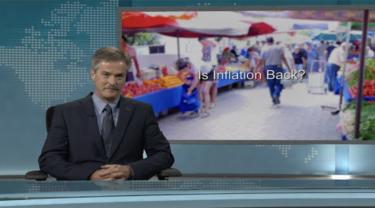Prices are rising again in a way we haven’t seen for years. That’s usually enough to set off groans all over. After all, inflation is one of the two ingredients of the ‘misery index’, generally regarded as an economic no-no. We’ve been without it for so long that the word itself had all but dropped from the vernacular. But its absence brought no joy; it was missing for all the wrong reasons – weak demand, structural challenges, uncertainty on multiple fronts. So if it’s back, should we be ecstatic, relieved or worried?
Recent history serves up a good answer. Prices rose sharply in 2008 as demand pressed the limits of productive capacity the world over, and concern mounted. Recession fixed that: consumer prices plunged, tumbling onto the red in the US, Canada and Japan, and getting close to negative numbers in Europe. But the movement didn’t calm concerns, it exacerbated them. Inflation is bad, but deflation is worse. Perplexity turned into panic as job 1 became stabilization. Considerable efforts paid off: prices did revive, meandering in a slow-growth range for about 5 years. We still weren’t happy, though, as prices were reflecting stubbornly sluggish demand. Then in mid-2014, panic 2.0: prices slumped again, sparking fears that even the meager growth we were seeing was faltering.
Those worries lasted about a year. Then, in late 2015, prices found their feet again, and rose, although growth was quite modest. We still weren’t happy. It seems that at long last, the world swung into gear in mid-2016. Since then, prices in most of the developed world have climbed up into target range, and in some cases, above target for brief episodes.
Are we happy yet? Not exactly; the speed of the price updraft has ignited concern that the ultra-loose monetary policy of the past 7 years will send prices skyward. Monetary authorities are all talking tightening, including plans for a balance sheet normalization that will see the mopping up of excess liquidity, first by the Fed, and then others in sequence. Their worry is that they’ll get behind the curve; given the lags in the monetary transmission mechanism, they need to act on inflation 12-18 months ahead of its onset to achieve stability. Seeing this, businesses are keen to know how to arm themselves for higher borrowing costs, and consumers, well used to cheap money by now, are concerned about the impact on their finances.
The worries are well-founded. Years of sub-par growth have stanched investment and hiring. Now, nascent growth is putting pressure on the tightly-managed capacity in place. Broad evidence of pent-up demand suggests that there’s lots of growth still coming. If anything, price pressures are going to be with us in the coming months. It’s key to know that this new price spurt – obvious in North America, Western Europe and even Japan – is happening for good reasons, conditions we have longed for since the recession. In that sense, a little inflation is not a bad thing. But as it occurs, the greater worry is managing price expectations. If those get out of hand, they’re difficult to control without tough monetary medicine.
Canada’s recent experience is similar to everyone else’s, although the context for us is a bit different. Where others are seeing pent-up demand, Canada’s internal fundamentals are more frothy. Consumers are carrying outsized and growing debt loads, making them more acutely sensitive to interest rate hikes. The housing market is in bubble territory, and also vulnerable to monetary tightening. But the irrepressible intensity of domestic activity together with recent red-hot export growth now has the Bank of Canada in rate-ratchet mode.
The shift is a key challenge not only for Canada but for monetary authorities everywhere. What we are witnessing is a welcome but worrisome regime shift, from ultra-loose financing to what we used to know as normal. Step-wise moves are necessary to avoid disrupting growth, but choosing the appropriate tightening path is not for the faint of heart. What is clear is that there is now less uncertainty about the need to move; even the ‘doves’ are thinking they need to be faster rather than slower.
The bottom line?
It seems like when it comes to demand conditions, we have what we all wished for. But we’re still not happy. Realizing our dreams comes with a price tag that these days seems to be changing rapidly. Buckle up for the ride!





